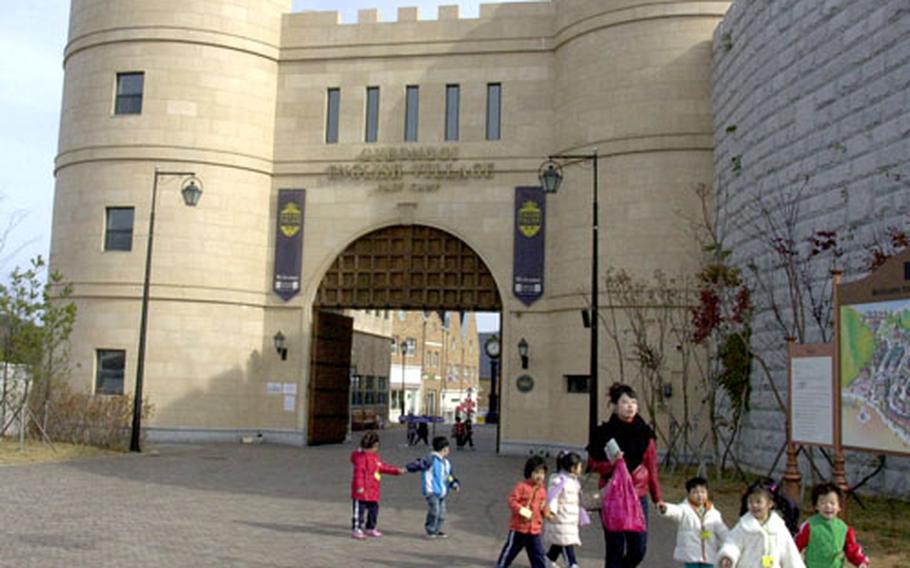
Paju, South Korea’s Gyeonggi English Village is a $97 million English-language immersion town designed to help local students gain English proficiency in real-world situations. (Erik Slavin / Stars and Stripes)
PAJU, South Korea — Ten minutes from the Imjin River and a broad swath of North Korea’s barren mountains, a replica of Stonehenge stands next to a medieval English castle façade.
Walk through the castle entrance and San Francisco-style streetcars move visitors on rails past Market Street’s restaurants and shopping.
South Korean children squeal “hello!” at any foreign face as they walk toward the monument-like broad steps of city hall.
The $97 million Gyeonggi English Village feels like a cross between a Hollywood movie set and a theme park. Indeed, film crews and top South Korean actors use it as a convenient location when they need a Western motif.
However, the village’s mission is to feed the compulsion that many South Korean parents have for teaching their children English.
Many students spend their evenings after school going to English schools, known as “hakwons.” They become skilled at grammar and writing, teachers say, but they often lack conversational skills.
It’s a problem that Gyeonggi English Village tries to counteract by immersing them in a world of English transactions at grocery stores, restaurants, post offices and museums.
The village also concentrates on the “English divide” — a belief that knowing English leads to better jobs, though many South Koreans start out at an economic disadvantage. “Wealthy students get educated in English, but if they’re poor, they don’t have as much access,” said Kwon Eun-hee, the village’s public relations manager.
Twenty percent of village programs are subsidized for underprivileged youth, Kwon said. They pay 80,000 won, or about $72, for a week of education, with room and board included.
Students can take classes lasting from one day up to four weeks. They learn from 108 foreign teachers and 50 South Korean assistant teachers.
The foreign teachers, like David Lemay of Boston, live in well-appointed apartments inside the village. They teach children ranging from kindergarten to ninth grade. When their day is over, they can grab dinner at places like Genghis Khan’s barbecue, or head for the English pub, which serves its own microbrew beer.
“It’s kind of like college, except there is no homework after classes,” said Lemay, 26, an actor and former teacher in the Bronx who answered an ad for the village that he saw in a U.S. magazine.
The park averages about 2,000 visitors a day on weekdays and 8,000 on weekends, Kwon said. Many of the weekday visitors are kindergartners and other young children. Tourists also are welcome, she said.
The weekends, especially during summer’s carnival-like atmosphere, make the village an unusual living experience, said teacher Dain Leatham.
“It’s very surreal when there are people all over and you’re just trying to get to and from your apartment to the gym,” Leatham said. The flip side of it comes after work, when “there are about 100 people walking around at night, and it’s like your own playground,” he added.
If you go...
Gyeonggi English Village is accessible from Seoul by taking Bus 200 from Hapjeong Station, or Bus 900 from Maegum-dong.
By car, take the Jayuro Expressway. Fifteen minutes from the Ilsan Asanpo IC, take the Seongdong IC by exiting on the first right. For further directions, call (031)-1588-0554, or (031)-956-2323.
Admission is 2,000 won (about $2) per person.
The park is next to the Haeri Artists’ Colony, which is also open to the public.